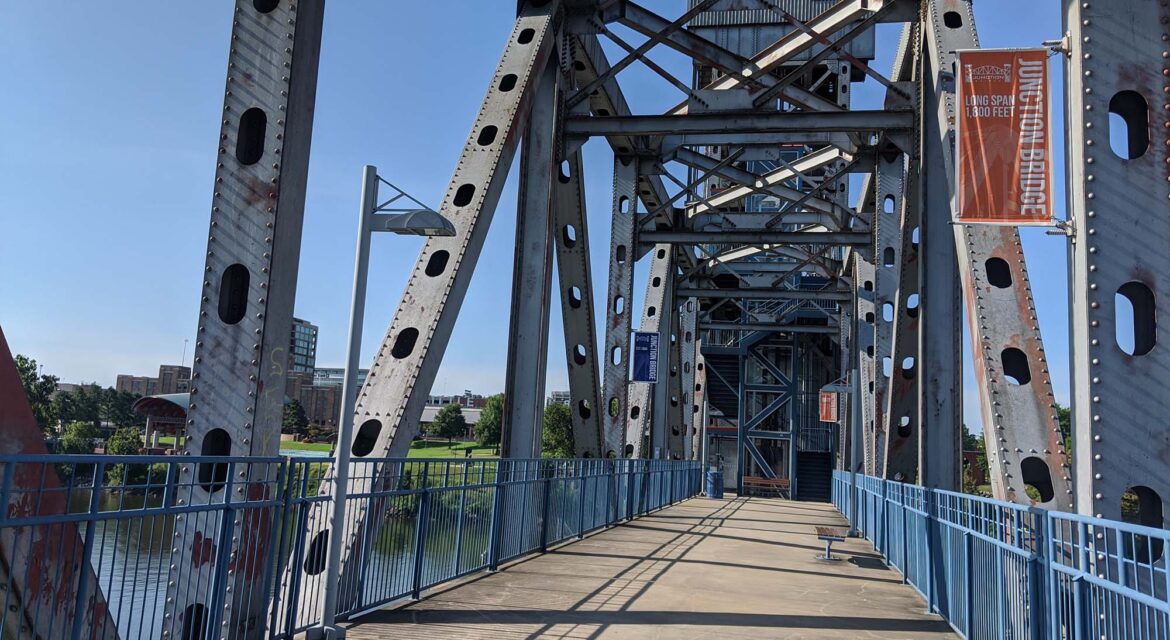 Spanning the Arkansas River to connect the cities of Little Rock and North Little Rock, Junction Bridge has defined the skyline of both cities for over 100 years. Over the course of those decades, the railroad bridge that was originally designed to connect all of Arkansas has been transformed into a pedestrian walkway that benefits the entire community. It serves as a physical link to the Arkansas River Trail system as well as a metaphorical link to the past of the city, both of which have enriched the economy and culture of the entire region.
Spanning the Arkansas River to connect the cities of Little Rock and North Little Rock, Junction Bridge has defined the skyline of both cities for over 100 years. Over the course of those decades, the railroad bridge that was originally designed to connect all of Arkansas has been transformed into a pedestrian walkway that benefits the entire community. It serves as a physical link to the Arkansas River Trail system as well as a metaphorical link to the past of the city, both of which have enriched the economy and culture of the entire region.

From Railroad Bridge to Pedestrian Walkway
Originally constructed in 1884 as a railroad bridge connecting the northern and southern Union Pacific railway lines, the Junction Bridge was built on the “Point of Rocks” which contained Le Petite Roche and changed the historic area forever. The bridge served as a critical junction in what would be the first unbroken line of railway to connect the entire state.
 The bridge was refloored in 1917 to accommodate use by heavier vehicles but was rebuilt in 1970 when its swing span was replaced with a lift span. Shifting economics and priorities meant the bridge was utilized less and less. In 1984 Junction Bridge was finally closed to rail traffic. In 1999, it was ceded to the city of Little Rock.
The bridge was refloored in 1917 to accommodate use by heavier vehicles but was rebuilt in 1970 when its swing span was replaced with a lift span. Shifting economics and priorities meant the bridge was utilized less and less. In 1984 Junction Bridge was finally closed to rail traffic. In 1999, it was ceded to the city of Little Rock.
That development began a process to rehabilitate Junction Bridge as a pedestrian and bicycle bridge. The project saw the lift span locked into place, 38 feet above the water, to allow river traffic to pass, along with many other improvements to make the bridge appropriate for pedestrian traffic. Dedicated in 2008, the new Junction Bridge has helped define the Arkansas River Trail System that runs 17 miles along both sides of the Arkansas River.
The transformation of Junction Bridge has enabled audiences of all types to experience the natural and urban surroundings in a way that has facilitated activity across the community and beyond.

The Best Views of the Arkansas River
The Junction Bridge is accessed by a walkway behind the River Market pavilion on the Little Rock side and from Washington Street on the North Little Rock side. Numerous benches and open areas allow visitors to take in the scenery over the river, some of which have been directly supported by the community. The best views of the Arkansas River as well as the skylines of Little Rock and North Little Rock can be experienced on the Junction Bridge.
 Junction Bridge has and continues to serve as an essential element of the surrounding communities. When the bridge was dedicated, a ceremonial “Tying Our Cities Together” was held at the bridge. It featured two 900 foot lengths of ribbon reaching from each end of the bridge. Groups from schools in the community brought the ribbon together at the center for a symbolic tying of the cities. Junction Bridge continues to host these types of special community events as well.
Junction Bridge has and continues to serve as an essential element of the surrounding communities. When the bridge was dedicated, a ceremonial “Tying Our Cities Together” was held at the bridge. It featured two 900 foot lengths of ribbon reaching from each end of the bridge. Groups from schools in the community brought the ribbon together at the center for a symbolic tying of the cities. Junction Bridge continues to host these types of special community events as well.
Available for rental use by private parties, community leaders are looking to turn the structure into an “inhabited bridge” complete with an attached restaurant, hotel, or office building on the North Little Rock side. The collaborative is also exploring the option of pulling a number of stainless steel rail cars onto the bridge as covered restaurant spaces. These options are in addition to bench dedications that serve as a direct source of revenue.
The transformation of the Junction Bridge has allowed it to become a premier destination in Arkansas for both residents and visitors. It highlights what it can mean for a piece of infrastructure to serve as a monument in and of itself while also being part of a larger initiative that produces untold benefits for everyone.
A Legacy of Little Rock
 The Junction Bridge has become a landmark of the area that residents and visitors can interact with in numerous ways. These interactions are the result of an effort to transform a piece of Little Rock history that might otherwise have been lost, highlighting what it can mean to create a legacy that connects the past and future of an entire region.
The Junction Bridge has become a landmark of the area that residents and visitors can interact with in numerous ways. These interactions are the result of an effort to transform a piece of Little Rock history that might otherwise have been lost, highlighting what it can mean to create a legacy that connects the past and future of an entire region.


